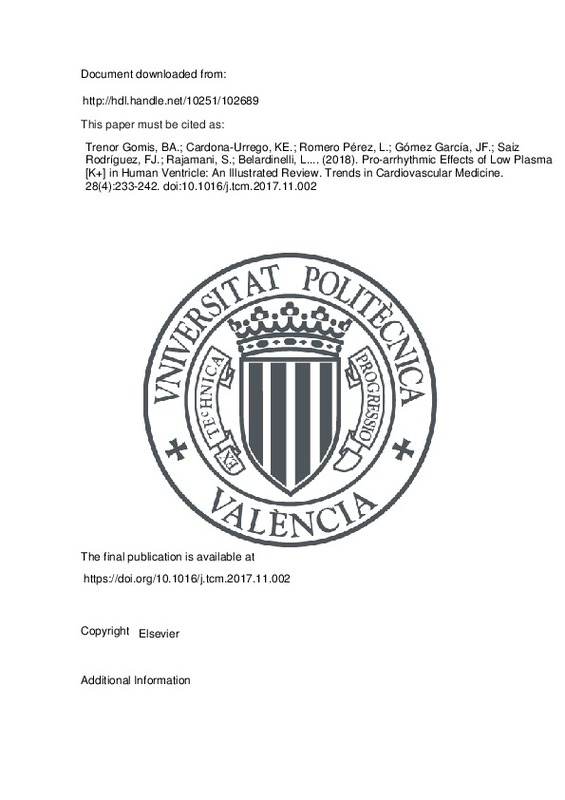JavaScript is disabled for your browser. Some features of this site may not work without it.
Buscar en RiuNet
Listar
Mi cuenta
Estadísticas
Ayuda RiuNet
Admin. UPV
Pro-arrhythmic Effects of Low Plasma [K+] in Human Ventricle: An Illustrated Review
Mostrar el registro sencillo del ítem
Ficheros en el ítem
| dc.contributor.author | Trénor Gomis, Beatriz Ana
|
es_ES |
| dc.contributor.author | Cardona-Urrego, Karen Eliana
|
es_ES |
| dc.contributor.author | Romero Pérez, Lucia
|
es_ES |
| dc.contributor.author | Gómez García, Juan Francisco
|
es_ES |
| dc.contributor.author | Saiz Rodríguez, Francisco Javier
|
es_ES |
| dc.contributor.author | Rajamani, Sridharan
|
es_ES |
| dc.contributor.author | Belardinelli, Luiz
|
es_ES |
| dc.contributor.author | Giles, Wayne
|
es_ES |
| dc.date.accessioned | 2018-05-26T04:20:10Z | |
| dc.date.available | 2018-05-26T04:20:10Z | |
| dc.date.issued | 2018 | es_ES |
| dc.identifier.issn | 1050-1738 | es_ES |
| dc.identifier.uri | http://hdl.handle.net/10251/102689 | |
| dc.description.abstract | [EN] Potassium levels in the plasma, [Kþ]o, are regulated precisely under physiological conditions. However, increases (from approx. 4.5 to 8.0 mM) can occur as a consequence of, e.g., endurance exercise, ischemic insult or kidney failure. This hyperkalemic modulation of ventricular electrophysiology has been studied extensively. Hypokalemia is also common. It can occur in response to diuretic therapy, following renal dialysis, or during recovery from endurance exercise. In the human ventricle, clinical hypokalemia (e.g., [Kþ]o levels of approx. 3.0 mM) can cause marked changes in both the resting potential and the action potential waveform, and these may promote arrhythmias. Here, we provide essential background information concerning the main Kþ-sensitive ion channel mechanisms that act in concert to produce prominent short-term ventricular electrophysiological changes, and illustrate these by implementing recent mathematical models of the human ventricular action potential. Even small changes (~1 mM) in [Kþ]o result in significant alterations in two different Kþ currents, IK1 and HERG. These changes can markedly alter in resting membrane potential and/or action potential waveform in human ventricle. Specifically, a reduction in net outward transmembrane Kþ currents (repolarization reserve) and an increased substrate input resistance contribute to electrophysiological instability during the plateau of the action potential and may promote pro-arrhythmic early after-depolarizations (EADs). Translational settings where these insights apply include: optimal diuretic therapy, and the interpretation of data from Phase II and III trials for anti-arrhythmic drug candidates. | es_ES |
| dc.description.sponsorship | In Valencia, this work was supported by: (i) the “Plan Estatal de Investigación Científica y Técnica y de Innovación 2013–2016” from the Ministerio de Economía, Industria y Competitividad of Spain (DPI2016-75799-R) and AEI/FEDER, UE, and by the “Programa Prometeu (PROMETEU/2016/088) de la Conselleria d'Educació, Formació I Ocupació, Generalitat Valenciana”. and (v) GileadSciences, Ltd. Wayne Giles acknowledges receipt of financial support in the form of a salary award (Medical Scientist) from Alberta Innovates-Health Solutions, and operating funding from the Canadian Institutes for Health Research and the Heart and Stroke Foundation of Alberta. | es_ES |
| dc.language | Inglés | es_ES |
| dc.publisher | Elsevier | es_ES |
| dc.relation.ispartof | Trends in Cardiovascular Medicine | es_ES |
| dc.rights | Reserva de todos los derechos | es_ES |
| dc.subject | Plasma K+, [K+]oK+ currents | es_ES |
| dc.subject | Inward rectification | es_ES |
| dc.subject | Repolarization | es_ES |
| dc.subject | Arrhythmias | es_ES |
| dc.subject | Early after-depolarizations (EADs) | es_ES |
| dc.subject | Mathematical simulations | es_ES |
| dc.subject | Drug safety evaluations | es_ES |
| dc.subject | (CiPA) | es_ES |
| dc.subject.classification | TECNOLOGIA ELECTRONICA | es_ES |
| dc.title | Pro-arrhythmic Effects of Low Plasma [K+] in Human Ventricle: An Illustrated Review | es_ES |
| dc.type | Artículo | es_ES |
| dc.identifier.doi | 10.1016/j.tcm.2017.11.002 | es_ES |
| dc.relation.projectID | info:eu-repo/grantAgreement/MINECO//DPI2016-75799-R/ES/TECNOLOGIAS COMPUTACIONALES PARA LA OPTIMIZACION DE TERAPIAS PERSONALIZADAS DE PATOLOGIAS AURICULARES Y VENTRICULARES/ | es_ES |
| dc.relation.projectID | info:eu-repo/grantAgreement/GVA//PROMETEO%2F2016%2F088/ES/MODELOS COMPUTACIONALES PERSONALIZADOS MULTI-ESCALA PARA LA OPTIMIZACION DEL DIAGNOSTICO Y TRATAMIENTO DE ARRITMIAS CARDIACAS (PERSONALISED DIGITAL HEART)/ | es_ES |
| dc.rights.accessRights | Abierto | es_ES |
| dc.date.embargoEndDate | 2019-05-31 | es_ES |
| dc.contributor.affiliation | Universitat Politècnica de València. Departamento de Ingeniería Electrónica - Departament d'Enginyeria Electrònica | es_ES |
| dc.description.bibliographicCitation | Trénor Gomis, BA.; Cardona-Urrego, KE.; Romero Pérez, L.; Gómez García, JF.; Saiz Rodríguez, FJ.; Rajamani, S.; Belardinelli, L.... (2018). Pro-arrhythmic Effects of Low Plasma [K+] in Human Ventricle: An Illustrated Review. Trends in Cardiovascular Medicine. 28(4):233-242. https://doi.org/10.1016/j.tcm.2017.11.002 | es_ES |
| dc.description.accrualMethod | S | es_ES |
| dc.relation.publisherversion | https://doi.org/10.1016/j.tcm.2017.11.002 | es_ES |
| dc.description.upvformatpinicio | 233 | es_ES |
| dc.description.upvformatpfin | 242 | es_ES |
| dc.type.version | info:eu-repo/semantics/publishedVersion | es_ES |
| dc.description.volume | 28 | es_ES |
| dc.description.issue | 4 | es_ES |
| dc.relation.pasarela | S\345980 | es_ES |
| dc.contributor.funder | Generalitat Valenciana | es_ES |
| dc.contributor.funder | Alberta Innovates - Health Solutions | es_ES |
| dc.contributor.funder | Canadian Institutes of Health Research | es_ES |
| dc.contributor.funder | Heart and Stroke Foundation of Alberta | es_ES |
| dc.contributor.funder | Ministerio de Economía y Competitividad | es_ES |







![[Cerrado]](/themes/UPV/images/candado.png)

